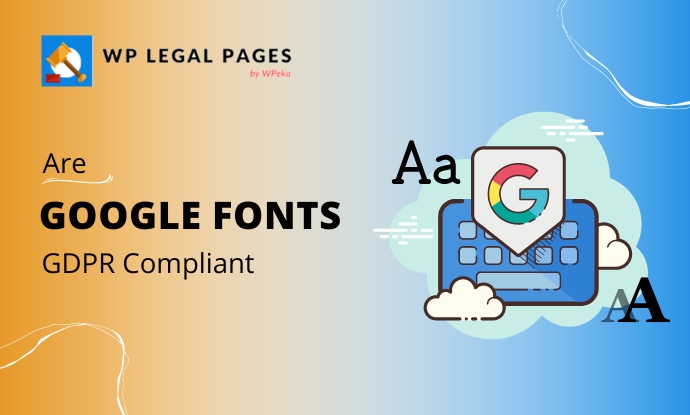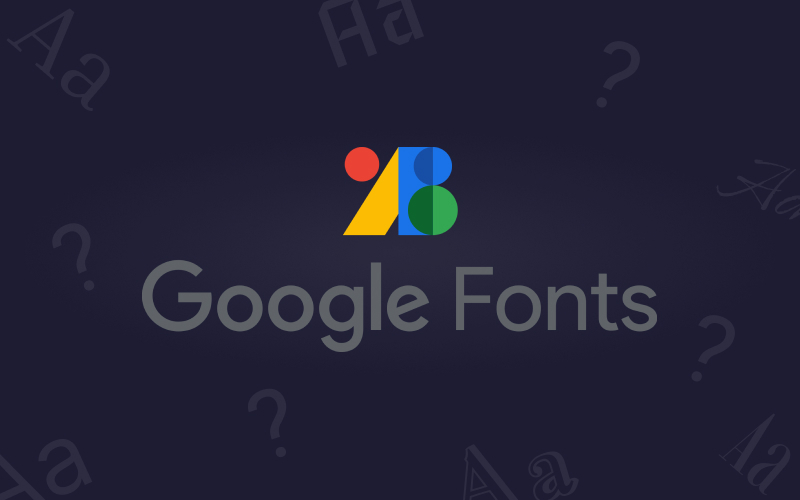Are Google Fonts GDPR Compliant? – A Beginner’s Guide

Google Fonts is a web font service that’s provided by Google. There are more than 1500+ font families, each with different unique styles.
Using these fonts, you can bring a unique texture to your content. For example, if you’re a blogger, it’s important to choose a font that is appealing to the reader’s eyes. Similarly, you can use a simple but elegant font style for your website.
However, running a website or blog site involves several privacy regulations to protect users’ data. One such law is the General Data Protection Regulation (GDPR).
GDPR is one of the world’s strictest laws as it governs multiple privacy regulations for people under the European Union.
Since we’ve spoken about Google Fonts and the GDPR law, the question arises: are Google Fonts GDPR compliant?
Read more to find out!
What is Google Fonts?

Google Fonts is one of the most popular web font services provided by Google. It allows website creators, including developers, designers, and marketers, to integrate various fonts into their websites or applications to enhance the typography and overall design.
Linking your website with Google Fonts is easy, as you can load them remotely from Google’s servers.
Google Fonts offers a vast collection of open-source fonts that you can use across different platforms. The service is widely used due to its ease of implementation, broad selection of fonts, and the fact that it enhances the consistency of font rendering across various devices and browsers.
Does the Use of Google Fonts Violate GDPR Law?
Yes, the use of Google Fonts violates the GDPR law.
When a user opens a website incorporating Google Fonts, the process involves a request from the user’s browser to Google’s servers to obtain the necessary font files. In this transaction, the user’s IP address is sent to Google to facilitate the delivery of the fonts.
The Google Fonts API then retrieves and downloads the required font files and CSS code, storing them in the user’s browser cache for future use.
General Data Protection Regulation (GDPR) regulations classify IP addresses as personally identifiable information (PII).
Hence, if a website utilizes Google Fonts, it’s necessary to obtain users’ consent. This means the website must receive the consent first and then load Google Fonts from the Google servers. If the user does not provide consent for collecting his/her device’s IP address or is not informed about the usage of Google Fonts, then the usage of Google Fonts would violate GDPR!
GDPR places a high value on transparency and user choice, requiring organizations to obtain clear and informed consent from individuals to process their personal data. Therefore, website owners using Google Fonts should consider implementing mechanisms to inform users about the data collection associated with font loading and seek explicit consent.
Now, if you’re a website user and are using Google Fonts, you must be thinking about how to comply with GDPR. The answer is simple. In the next section, we have explored the various ways in which you can make Google Fonts GDPR compliant.
How to Make Google Fonts GDPR Compliant
Google Fonts-GDPR compliance is not an impossible task.
In order to align with GDPR regulations, it is necessary to manage the integration of Google Fonts into a website carefully.
Here are some of the ways you can make Google Fonts comply with the GDPR law:
Method1: Get User Consent
When using Google Fonts directly from Google servers, it is advisable to implement a Cookie Banner on your website. Websites using cookies or other tracking technologies must obtain explicit consent from users to manage their personal data.
This involves informing users about collecting their IP addresses and requesting consent before initiating the request for Google Fonts.
One approach to ensure compliance is to block the Google Fonts API until user consent is obtained. This means that web pages will only load the required fonts if users have given explicit consent beforehand or if the required font files and CSS code are already in the user’s browser cache.
For those with an empty browser cache or users who haven’t given consent, the website should refrain from loading Google Fonts. This aligns with GDPR principles, as user consent is a fundamental aspect of data processing.
To get consent from users, you can use the cookie consent banner through the WP Cookie Consent plugin, which provides you with multiple templates and customization settings.
Method 2: Host Google Fonts Locally
Downloading Google Fonts files and hosting them on your website server eliminates the need to send personal data to Google’s servers, thus ensuring GDPR compliance. This involves downloading the font files, uploading them to your host, and providing CSS rules for your web pages.
Method 3: Use the OMGF WordPress Plugin
The OMGF (Optimize My Google Fonts) plugin offers a convenient solution for WordPress users. It automatically downloads the required Google Fonts, generates a stylesheet, and integrates it into your site’s header. This enables local hosting of Google Fonts, aligning with GDPR requirements.
Method 4: Utilize Default WordPress Fonts
WordPress users can opt for the simplest solution by using the default system fonts stored locally on their servers, thereby avoiding connections to Google servers and eliminating the need to transmit user data.
When using Google Fonts directly from Google servers, it is advisable to implement a Cookie Banner on your website. Websites using cookies or other tracking technologies must obtain explicit consent from users to manage their personal data.
Modifying the Google Fonts code to include user consent information is recommended, as illustrated by the example with the Roboto code.
Additional Information
When Google Fonts are sourced from Google servers, a Privacy Policy becomes essential, as it is bound by Google’s generic API terms of service. This policy should detail the collection, storage, and potential processing of users’ IP addresses and personal data. You can use the free WP Legal Pages plugin to create a free privacy policy.
If tracking technologies are employed, even if Google Fonts don’t use cookies, a Cookie Policy and Cookie Banner are recommended to inform users about possible tracking technologies and obtain their consent.
For a comprehensive solution in managing user consent and ensuring GDPR compliance, the use of a Consent Management Platform, such as CookieScript, is recommended. Such platforms facilitate the creation of both Privacy and Cookie Policies, helping website owners navigate the complexities of data protection regulations effectively.
Conclusion
Google Fonts, in general, do not collect any cookies. However, a website that uses Google Fonts API is prone to violating GDPR laws.
When a user opens a website containing Google Fonts, the browser sends the request to the Google server via the Google Fonts API to fetch the fonts. During this process, the user’s IP address is sent to Google to facilitate the delivery of the fonts.
Collecting of user’s IP address without obtaining consent from users is said to violate the GDPR law. To overcome this, you can create a cookie consent banner that includes a detailed policy of the usage of the user’s IP address.
Thinking of creating a cookie consent banner, we recommend using the WP Cookie Consent plugin for its ease of use and advanced features.
If you’ve liked reading this article, check out our other insightful articles as well:
- Do I Need A Privacy Policy For My Website? – A Beginner’s Guide
- Simplified Guide To Set Up Cookie Banners For eCommerce
- How To Add A Cookie Consent Popup To Your WordPress Website?
Are you looking to create privacy policy, cookie policy or even terms of use legal pages, grab the WP Legal Pages plugin.